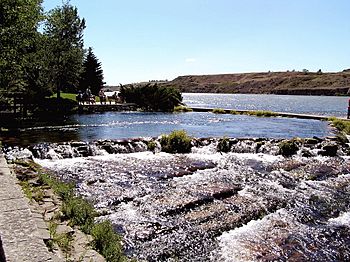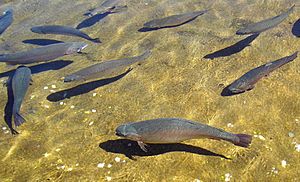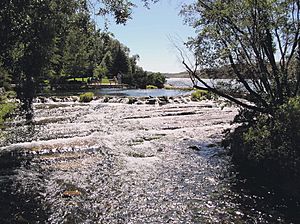Giant Springs facts for kids
Quick facts for kids Giant Springs |
|
|---|---|

Giant Springs
|
|
| Other name(s) | Big Spring, Wonderful Spring, Roe River, North Fork Roe River |
| Country | United States |
| State | Montana |
| District | Cascade County |
| City | Great Falls |
| Physical characteristics | |
| Main source | Montana |
| River mouth | Missouri River Great Falls, Cascade County, Montana 3,314 ft (1,010 m) |
| Length | 0.04 mi (0.064 km) |
Giant Springs is a very large spring located near Great Falls, Montana. It is the main attraction of Giant Springs State Park. The water here always stays at 54 °F (12 °C). This water comes from melted snow in the Little Belt Mountains, which are about 60 miles (97 km) away. Scientists have studied the water. They believe it takes about 3,000 years for the water to travel underground before it comes out at the springs.
Contents
What is Giant Springs?
Giant Springs is formed by an opening in a huge underground water storage area. This area is called the Madison aquifer. An aquifer is like a giant sponge made of rock that holds water underground. This particular aquifer stretches under five U.S. states and three Canadian provinces!
How the Water Travels
The water travels from the mountains through a special layer of rock. This rock layer is known as the Madison Limestone. It acts like a hidden pipeline. While some water comes out at Giant Springs, other water keeps flowing underground. This water joins up with water from other places. Eventually, this underground river reaches the surface far away in Canada.
How Much Water Flows?
Giant Springs is truly giant! It releases a huge amount of water. On average, about 242 cubic feet (6.9 m3) of water flows out every second. That's like 150 million gallons of water every single day!
History of Giant Springs
The spring outlet is found within Giant Springs State Park. This park is just a short distance from Great Falls, Montana. It sits on the east bank of the Missouri River.
Early Discoveries
The famous explorers Lewis and Clark first wrote about Giant Springs. They saw it during their journey in 1805. This was when they were exploring the land bought in the Louisiana Purchase. Even before them, the Blackfeet people used the springs. It was an important source of water, especially during the cold winter months.
From Recreation to Park
For many years, settlers did not pay much attention to the springs. But after the town of Great Falls was started in 1884, things changed. The springs became a popular spot for people to visit on Sundays. They would go there for fun and relaxation. In the mid-1970s, the area officially became a Montana State Park.
Giant Springs Today
Today, Giant Springs is still a very important place. Some of its clean water is bottled every year for people to drink. The spring also helps a special fish farm.
The Fish Hatchery
Part of the spring's water is used for a trout hatchery. This is a Montana state fish farm called Giant Springs Trout Hatchery. They mostly raise Rainbow trout here. It's a great place to see many fish!

The Shortest River
Giant Springs is also the starting point for the Roe River. This river is only about 200-foot (61 m) long. It was once listed in the Guinness Book of World Records as the shortest river in the world! The Roe River flows directly into the Missouri River. The Missouri River is very close to the spring and forms one of the borders of the state park.


